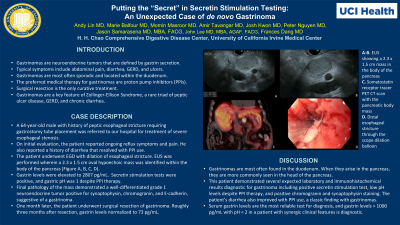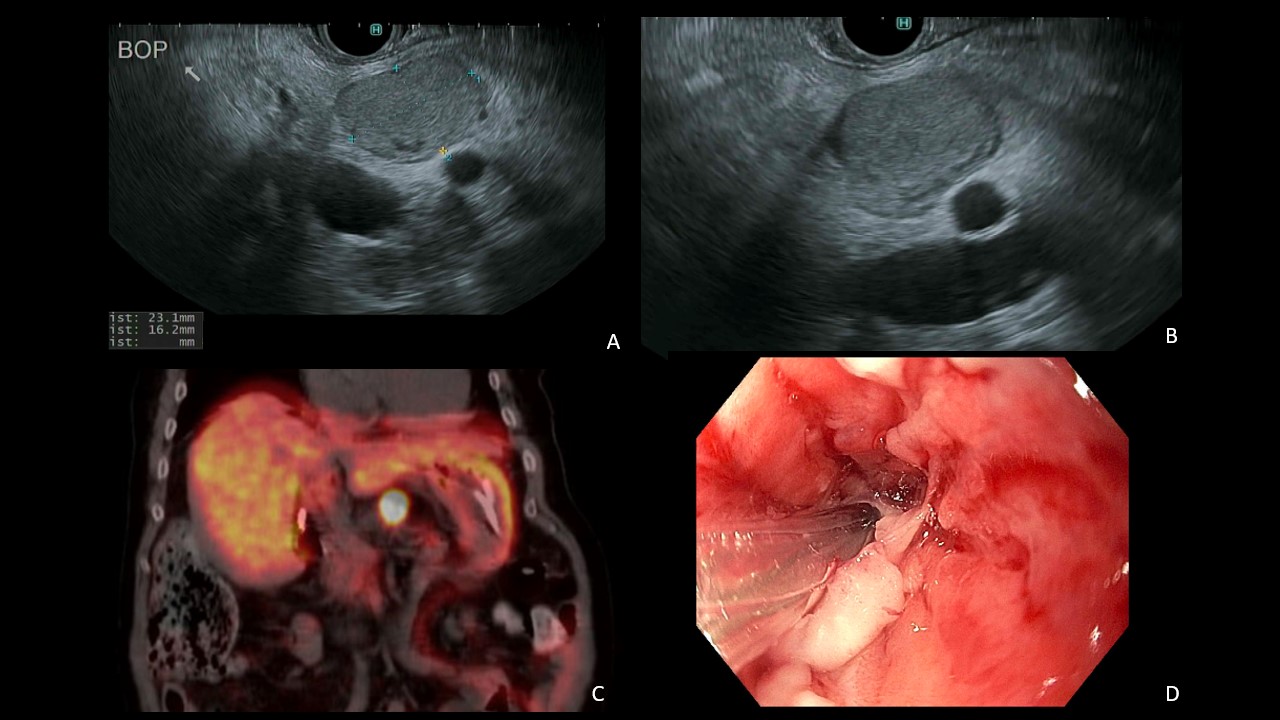Sunday Poster Session
Category: Biliary/Pancreas
P0127 - Putting the “Secret” in Secretin Stimulation Testing: An Unexpected Case of de novo Gastrinoma
Sunday, October 27, 2024
3:30 PM - 7:00 PM ET
Location: Exhibit Hall E

Has Audio
- AL
Andy L. Lin, MD
University of California, Irvine
Orange, CA
Presenting Author(s)
Andy L. Lin, MD1, Marie Balfour, MD1, Momin Masroor, MD1, Amirali Tavangar, MD1, Joshua Kwon, MD2, Peter H. Nguyen, MD1, Brian Mendoza, MD1, Michael Andrew Yu, MD1, Jason Samarasena, MD1, John G. Lee, MD1, Frances Dang, MD1
1University of California, Irvine, Orange, CA; 2University of California Irvine, Orange, CA
Introduction: Gastrinomas are neuroendocrine tumors that are defined by gastrin secretion. Typical symptoms of gastrinomas include abdominal pain and diarrhea, although patients can also present with gastroesophageal reflux (GERD) and ulcers. Gastrinomas are most often sporadic, located within the duodenum, and diagnosed between ages 20 to 50 years of age. Although the preferred medical therapy for gastrinomas are proton pump inhibitors (PPIs), surgical resection is the only curative treatment. Gastrinomas are a key feature of Zollinger-Ellison Syndrome, a rare triad of peptic ulcer disease, GERD, and chronic diarrhea.
Case Description/Methods: A 64-year-old male with history of erosive esophagitis complicated by esophageal stricture requiring gastrostomy tube placement was referred to our hospital for management of severe esophageal stenosis not traversable by a standard adult gastroscope. Previous CT imaging was negative for an abdominal mass. On initial evaluation, the patient reported ongoing reflux symptoms and pain. He also reported a history of diarrhea that resolved with PPI use. The patient underwent EGD with EUS wherein a 2.3 x 1.5 cm oval hypoechoic mass was identified within the body of the pancreas (Figure A, B, C, D). Gastrin levels were elevated to 2807 pg/mL. Secretin stimulation tests were positive, and gastric pH was 1 despite PPI therapy. Final pathology demonstrated lymph node involved well-differentiated grade 1 neuroendocrine tumor positive for synaptophysin, chromogranin, and E-cadherin, suggestive of a gastrinoma. One month later, the patient underwent surgical resection of gastrinoma. Roughly three months after resection, gastrin levels normalized to 73 pg/mL.
Discussion: The findings in this patient demonstrate some of the expected features of Zollinger-Ellison Syndrome with a few unexpected twists. Gastrinomas are most often found in the duodenum. When they arise in the pancreas, they are more commonly seen in the head of the pancreas. This patient demonstrated several expected laboratory and immunohistochemical results diagnostic for gastrinoma including positive secretin stimulation test, low pH levels despite PPI therapy, and positive chromogranin and synaptophysin staining. The patient’s diarrhea also improved with PPI use, a classic finding with gastrinomas. Serum gastrin levels are the most reliable test for diagnosis, and gastrin levels > 1000 pg/mL with pH < 2 in a patient with synergic clinical features is diagnostic.

Disclosures:
Andy L. Lin, MD1, Marie Balfour, MD1, Momin Masroor, MD1, Amirali Tavangar, MD1, Joshua Kwon, MD2, Peter H. Nguyen, MD1, Brian Mendoza, MD1, Michael Andrew Yu, MD1, Jason Samarasena, MD1, John G. Lee, MD1, Frances Dang, MD1. P0127 - Putting the “Secret” in Secretin Stimulation Testing: An Unexpected Case of <i>de novo</i> Gastrinoma, ACG 2024 Annual Scientific Meeting Abstracts. Philadelphia, PA: American College of Gastroenterology.
1University of California, Irvine, Orange, CA; 2University of California Irvine, Orange, CA
Introduction: Gastrinomas are neuroendocrine tumors that are defined by gastrin secretion. Typical symptoms of gastrinomas include abdominal pain and diarrhea, although patients can also present with gastroesophageal reflux (GERD) and ulcers. Gastrinomas are most often sporadic, located within the duodenum, and diagnosed between ages 20 to 50 years of age. Although the preferred medical therapy for gastrinomas are proton pump inhibitors (PPIs), surgical resection is the only curative treatment. Gastrinomas are a key feature of Zollinger-Ellison Syndrome, a rare triad of peptic ulcer disease, GERD, and chronic diarrhea.
Case Description/Methods: A 64-year-old male with history of erosive esophagitis complicated by esophageal stricture requiring gastrostomy tube placement was referred to our hospital for management of severe esophageal stenosis not traversable by a standard adult gastroscope. Previous CT imaging was negative for an abdominal mass. On initial evaluation, the patient reported ongoing reflux symptoms and pain. He also reported a history of diarrhea that resolved with PPI use. The patient underwent EGD with EUS wherein a 2.3 x 1.5 cm oval hypoechoic mass was identified within the body of the pancreas (Figure A, B, C, D). Gastrin levels were elevated to 2807 pg/mL. Secretin stimulation tests were positive, and gastric pH was 1 despite PPI therapy. Final pathology demonstrated lymph node involved well-differentiated grade 1 neuroendocrine tumor positive for synaptophysin, chromogranin, and E-cadherin, suggestive of a gastrinoma. One month later, the patient underwent surgical resection of gastrinoma. Roughly three months after resection, gastrin levels normalized to 73 pg/mL.
Discussion: The findings in this patient demonstrate some of the expected features of Zollinger-Ellison Syndrome with a few unexpected twists. Gastrinomas are most often found in the duodenum. When they arise in the pancreas, they are more commonly seen in the head of the pancreas. This patient demonstrated several expected laboratory and immunohistochemical results diagnostic for gastrinoma including positive secretin stimulation test, low pH levels despite PPI therapy, and positive chromogranin and synaptophysin staining. The patient’s diarrhea also improved with PPI use, a classic finding with gastrinomas. Serum gastrin levels are the most reliable test for diagnosis, and gastrin levels > 1000 pg/mL with pH < 2 in a patient with synergic clinical features is diagnostic.

Figure: A-B. EUS showing a 2.3 x 1.5 cm mass in the body of the pancreas
C. Somatostatin receptor tracer PET CT scan with the pancreatic body mass
D. Distal esophageal stricture with through the scope dilation balloon
C. Somatostatin receptor tracer PET CT scan with the pancreatic body mass
D. Distal esophageal stricture with through the scope dilation balloon
Disclosures:
Andy Lin indicated no relevant financial relationships.
Marie Balfour indicated no relevant financial relationships.
Momin Masroor indicated no relevant financial relationships.
Amirali Tavangar indicated no relevant financial relationships.
Joshua Kwon indicated no relevant financial relationships.
Peter Nguyen indicated no relevant financial relationships.
Brian Mendoza indicated no relevant financial relationships.
Michael Andrew Yu indicated no relevant financial relationships.
Jason Samarasena: Cook Medical – Consultant. Medtronic – Advisory Committee/Board Member, Consultant. Neptune Medical – Advisory Committee/Board Member, Consultant. Olympus – Advisory Committee/Board Member, Consultant. Ovesco – Advisory Committee/Board Member, Consultant, Speakers Bureau. SatisfAI – Stock-privately held company. Steris – Advisory Committee/Board Member.
John Lee indicated no relevant financial relationships.
Frances Dang indicated no relevant financial relationships.
Andy L. Lin, MD1, Marie Balfour, MD1, Momin Masroor, MD1, Amirali Tavangar, MD1, Joshua Kwon, MD2, Peter H. Nguyen, MD1, Brian Mendoza, MD1, Michael Andrew Yu, MD1, Jason Samarasena, MD1, John G. Lee, MD1, Frances Dang, MD1. P0127 - Putting the “Secret” in Secretin Stimulation Testing: An Unexpected Case of <i>de novo</i> Gastrinoma, ACG 2024 Annual Scientific Meeting Abstracts. Philadelphia, PA: American College of Gastroenterology.

